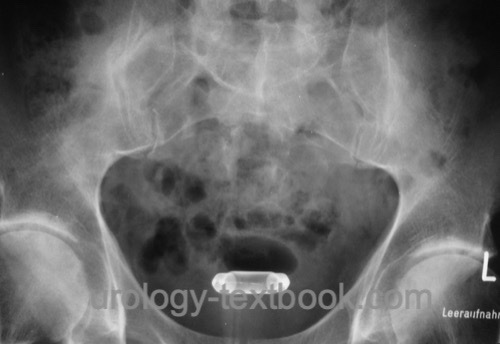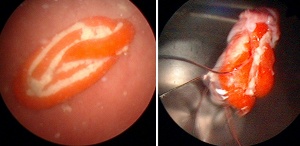You are here: Urology Textbook > Bladder > Foreign bodies
Foreign Bodies in the Bladder or Urethra: Diagnosis and Treatment
Autoerotic actions or mental confusion may lead to the introduction of foreign bodies (Latin: corpus alienum) into the urethra, which are left there or slipped away. The foreign body can migrate into the urinary bladder. Not every patient gives indications of the manipulation but reports urination problems, hematuria, or pain. If in doubt, cystoscopy or imaging (sonography, abdominal X-ray) should be performed [fig. light bulb in the bladder.
 |
Removal of Foreign Bodies from Bladder or Urethra
Depending on its size and stability, the foreign body is removed endoscopically or via open surgery (sectio alta) [fig. endoscopic removal of a candle fragment and removal of a cable from the bladder].
 |
| Do you want to see the illustration? Please support this website with a Steady membership. In return, you will get access to all images and eliminate the advertisements. Please note: some medical illustrations in urology can be disturbing, shocking, or disgusting for non-specialists. Click here for more information. |
| Bladder injury | Index | Bladder tamponade |
Index: 1–9 A B C D E F G H I J K L M N O P Q R S T U V W X Y Z
References
C. J. Palmer, M. Houlihan, S. P. Psutka, K. A. Ellis, P. Vidal, and C. M. P. Hollowell, “Urethral Foreign Bodies: Clinical Presentation and Management.,” Urology, vol. 97, pp. 257–260, 2016.
 Deutsche Version: Fremdkörper in der Harnblase
Deutsche Version: Fremdkörper in der Harnblase